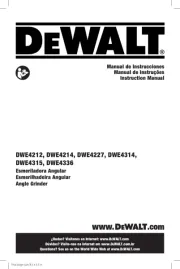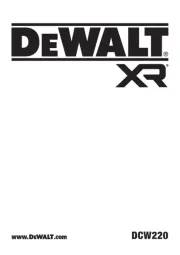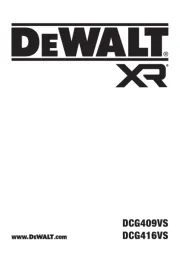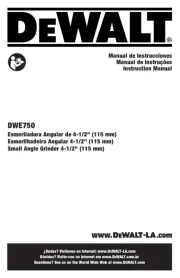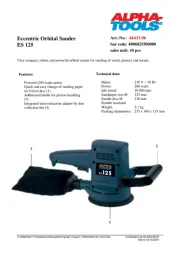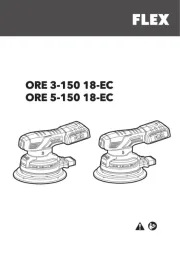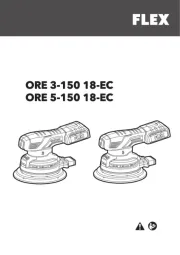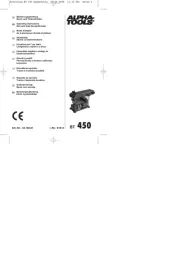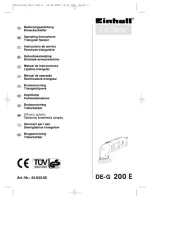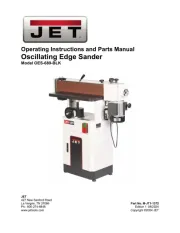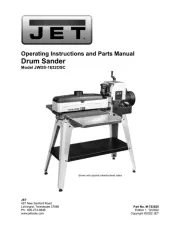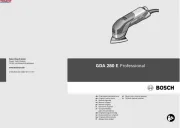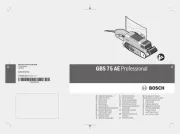INSTRUCTION MANUAL
GUIDE D'UTILISATION
MANUAL DE INSTRUCCIONES
DW430 3"x 21" Belt Sander
DW431 3"x 21" Variable Speed Belt Sander
DW430 Ponceuse à courroie (7,6 x 53,3 cm ou 3 x 21 po)
DW431 Ponceuse à courroie à vitesse variable (7,6 x 53,3 cm ou 3 po x 21 po)
DW430 3"x 21" Lijadora de banda
DW431 3"x 21" Lijadora de banda de velocidad variable
INSTRUCTIVO DE OPERACIÓN, CENTROS DE SERVICIO Y
PÓLIZA DE GARANTÍA. ADVERTENCIA: LÉASE ESTE
INSTRUCTIVO ANTES DE USAR EL PRODUCTO.
IF YOU HAVE ANY QUESTIONS OR COMMENTS ABOUT THIS OR ANY DEWALT TOOL,
CALL US TOLL FREE AT:
1-800-4-DEWALT (1-800-433-9258)
Important Safety Instructions
WARNING: When using electric tools, basic safety precautions should always be followed to
reduce risk of fire, electric shock, and personal injury, including the following:
READ ALL INSTRUCTIONS
Double Insulation
Double insulated tools are constructed throughout with two separate layers of electrical insula-
tion or one double thickness of insulation between you and the tool’s electrical system. Tools
built with this insulation system are not intended to be grounded. As a result, your tool is
equipped with a two prong plug which permits you to use extension cords without concern for
maintaining a ground connection.
NOTE: Double insulation does not take the place of normal safety precautions when operating
this tool. The insulation system is for added protection against injury resulting from a possible
electrical insulation failure within the tool.
CAUTION: WHEN SERVICING USE ONLY IDENTICAL REPLACEMENT PARTS. Repair or
replace damaged cords
Polarized Plugs
Polarized plugs (one blade is wider than the other) are used on equipment to reduce the risk of
electric shock. When provided, this plug will fit into a polarized outlet only one way. If the plug
does not fit fully in the outlet, reverse the plug. If it still does not fit, contact a qualified electrician
to install the proper outlet. Do not change the plug in any way. The polarized statementNOTE:
may be omitted if the unit is rated higher than 120 volts.
Safety Instructions For All Tools
• KEEP WORK AREA CLEAN. Cluttered areas and benches invite injuries.
• CONSIDER WORK AREA ENVIRONMENT. Don’t expose power tools to rain. Don’t use
power tools in damp or wet locations. Keep work area well lit. Do not use tool in presence of
flammable liquids or gases.
• GUARD AGAINST ELECTRIC SHOCK. Prevent body contact with grounded surfaces. For
example; pipes, radiators, ranges, and refrigerator enclosures.
• KEEP CHILDREN AWAY. Do not let visitors contact tool or extension cord. All visitors should
be kept away from work area.
• STORE IDLE TOOLS. When not in use, tools should be stored in dry, and high or locked-up
place — out of reach of children.
• DON’T FORCE TOOL. It will do the job better and safer at the rate for which it was intend-
ed.
• USE RIGHT TOOL. Don’t force small tool or attachment to do the job of a heavy-duty tool.
Don’t use tool for purpose not intended.
• DRESS PROPERLY. Do not wear loose clothing or jewelry. They can be caught in moving
parts. Rubber gloves and non-skid footwear are recommended when working outdoors.
Wear protective hair covering to contain long hair.
•USE SAFETY GLASSES. Also use face or dust mask if cutting operation is dusty.
• DON’T ABUSE CORD. Never carry tool by cord or yank it to disconnect from receptacle.
Keep cord from heat, oil, and sharp edges.
• SECURE WORK. Use clamps or a vise to hold work. It’s safer than using your hand and it
frees both hands to operate tool.
• DON’T OVERREACH. Keep proper footing and balance at all times.
• MAINTAIN TOOLS WITH CARE. Keep tools sharp and clean for better and safer perfor-
mance. Follow instructions for lubricating and changing accessories. Inspect tool cords peri-
odically and if damaged, have repaired by authorized service facility. Inspect extension cords
periodically and replace if damaged. Keep handles dry, clean, and free from oil and grease.
• DISCONNECT OR LOCK OFF TOOLS when not in use, before servicing, and when chang-
ing accessories, such as blades, bits, cutters.
• REMOVE ADJUSTING KEYS AND WRENCHES. Form habit of checking to see that keys
and adjusting wrenches are removed from tool before turning it on.
• AVOID UNINTENTIONAL STARTING. Don’t carry tool with finger on switch. Be sure switch
is off when plugging in.
• EXTENSION CORDS. Make sure your extension cord is in good condition. When using an
extension cord, be sure to use one heavy enough to carry the current your product will draw.
An undersized cord will cause a drop in line voltage resulting in loss of power and overheat-
ing. The following table shows the correct size to use depending on cord length and name-
plate ampere rating. If in doubt, use the next heavier gage. The smaller the gage number, the
heavier the cord.
Recommended Minimum Wire Size for Extension Cords
Total Length of Cord
25 ft. 50 ft. 75 ft. 100 ft. 125 ft. 150 ft. 175 ft.
7.6 m 15.2 m 22.9 m 30.5 m 38.1 m 45.7 m 53.3 m
Wire Size
18 AWG 18 AWG 16 AWG 16 AWG 14 AWG 14 AWG 12 AWG
• OUTDOOR USE EXTENSION CORDS. When tool is used outdoors, use only extension
cords intended for use outdoors and so marked.
• STAY ALERT. Watch what you are doing. Use common sense. Do not operate tool when you
are tired.
• CHECK DAMAGED PARTS. Before further use of the tool, a guard or other part that is dam-
aged should be carefully checked to determine that it will operate properly and perform its
intended function. Check for alignment of moving parts, binding of moving parts, breakage of
parts, mounting, and any other conditions that may affect its operation. A guard or other part
that is damaged should be properly repaired or replaced by an authorized service center
unless otherwise indicated elsewhere in this instruction manual. Have defective switches
replaced by authorized service center. Do not use tool if switch does not turn it on and off.
WARNING: Some dust created by power sanding, sawing, grinding, drilling, and other con-
struction activities contains chemicals known to cause cancer, birth defects or other reproduc-
tive harm. Some examples of these chemicals are:
• lead from lead-based paints,
• crystalline silica from bricks and cement and other masonry products, and
• arsenic and chromium from chemically-treated lumber (CCA).
Your risk from these exposures varies, depending on how often you do this type of work. To
reduce your exposure to these chemicals: work in a well ventilated area, and work with
approved safety equipment, such as those dust masks that are specially designed to filter out
microscopic particles.
Motor
Your DEWALT tool is powered by a DEWALT-built motor. Be sure your power supply agrees with
the nameplate marking.
Volts 50/60 Hz or “AC only” means your tool must be operated only with alternating current and
never with direct current.
Voltage decrease of more than 10% will cause loss of power and overheating. All D EWALT tools
are factory tested, if this tool does not operate, check the power supply.
CAUTION: When servicing all tools, USE ONLY IDENTICAL REPLACEMENT PARTS. Repair
or replace damaged cords.
Switch (Fig. 1)
Your sander starts and stops by depressing and releasing the switch (A). For continuous oper-
ation, press the lock button (B) located on the side of grip while switch is depressed. Depress
switch again to release the lock.
SPEED CONTROL SWITCH (DW431) (FIG. 2)
The speed control switch (A) varies the belt speed to allow the user to control sanding of sensi-
tive surfaces. Low belt speeds are better for sanding of paintwork or filler. The low belt speed
prevents the paint from overheating and avoids rapid wear of the belt. The lower the number the
slower the speed. Low speeds are suitable for light sanding with fine grit belts.
Attaching & Removing Dust Bag (Fig. 3)
BE SURE YOUR SANDER IS DISCONNECTED FROM POWER SUPPLY WHEN ATTACHING
AND REMOVING DUST BAG. To attach Dust Bag (A), slide recessed area of dust bag inlet over
the flange on the dust exit chute (B).
Although the bag is of ample size, it should be emptied frequently and shaken out to maintain
efficiency. Opening the zipper (C) on top of the bag allows complete cleaning.
Installing And Changing Abrasive Belt (Fig. 4 & 5)
BE SURE YOUR SANDER IS DISCONNECTED FROM POWER SUPPLY WHEN INSTALLING
AND CHANGING ABRASIVE BELT.
CAUTION: Avoid hand contact with the wear plate (A) as the edges can become very sharp.
Place sander on its side and lift lever (B) to retract front roller and release belt tension. Place
abrasive belt (C) over both rollers so that arrow on inside of belt is pointing in the direction of
rotation. Then push lever down to the original position to give tension to belt. Take care that
your fingers can’t be trapped.
TO REMOVE ABRASIVE BELT, lift lever in the arrowed direction to max. position so that the
front roller retracts inwards, then lift off the belt.
Tracking Adjustment (Fig. 6)
WEAR EYE PROTECTION
Turn the machine upside down, hold it firmly with one hand, start motor and release switch
immediately after observing tracking of sanding belt. If abrasive belt runs outward (A), turn track-
ing adjustment knob (B) clockwise and counterclockwise if belt runs inward (C).
Adjust the belt until the outer edge of the belt is even with the outer edge of both front and rear
rollers. Also check that the belt doesn’t rub against belt guide strip.
Belt life will be greatly increased by keeping the tracking adjustment set properly.
Operation (Figure 7)
First, hold the sander away from the work and start motor. When the motor comes up to its max-
imum speed, lower the sander onto the work with a slight forward motion. The main handle is
used to control the sander and the front auxiliary handle to guide it. Let the heel or rear drive
roller touch the work first, bringing the plate into full contact as the stroke moves forward. The
sander should be moved back and forth parallel to the grain of the wood. Don’t let the sander
stay in one place or the finish will be uneven. Short overlapping strokes produce the best results.
When sanding, avoid tilting the machine sideways as belt will make a deep cut into the work.
The weight of the machine itself is sufficient and extra pressure will only result in an uneven fin-
ish. Don’t force tool, allow the machine to work easily. Use the coarse grit abrasive belt for fast
sanding and finer grit for finishing.
Accessories
Recommended accessories for use with your tool are available at extra cost from your local ser-
vice center.
CAUTION: The use of any non-recommended accessory may be hazardous.
A complete listing of service centers is included on the owner’s registration card packed with
your tool.
If you need any assistance in locating any accessory, please contact D EWALT Industrial Tool
Co., 701 East Joppa Road, Baltimore, MD 21286 or call 1-800-4-D EWALT (1-800-433-9258).
DEWALT Industrial Tool Co., 701 East Joppa Road, Baltimore, MD 21286
Printed in U.S.A. (JUN00-CD-1) Form No. 158894-01 DW430 Copyright © 2000
Questions? See us in the World Wide Web at www.dewalt.com
